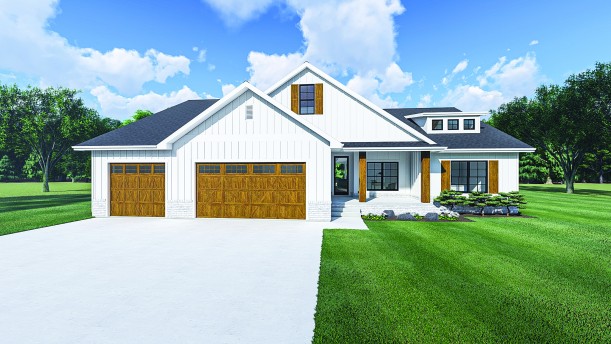Multigenerational Housing Market on the Rise in Omaha

An artist’s rendering from Todd Menard Construction shows the exterior of a multi-generational home. While the outside shows off a normal-looking single-family home, the interior allows room for a small, one-bedroom apartment complete with private living area, kitchenette, laundry and even a garage. (Todd Menard Construction via Post-Gazette)
The overall population keeps growing throughout the Omaha metro area, and the rise of multigenerational housing continues to peak local families’ interest.
Whether grandparents are retiring, an in-law losing their spouse or a child returning from college, multigenerational homes are for any extended family in a single-family setting and neighborhood.
These homes not only provide an opportunity for a single family, they also accommodate a small, one-bedroom apartment with a private living area, kitchenette, laundry and even a garage with a separate entrance to the home.
Gloria Menard Osborn, co-owner of Todd Menard Construction, said these homes are built for aging parents, caregivers and nannies, roommates sharing living costs, adult children moving back in, private guest living or for a family to use the extra space as a home office or hobby center.
“Because of the increase in home prices,” Osborn said, “what we’ve seen so far is that families are coming together to share those living costs. This also gives support to their extended family from personal, physical and financial support.”
According to a John Burns Real Estate Consulting survey, 41% of Americans who were looking for a new home planned to have an elderly parent or adult child living with them. A Pew Research study shows 20% of Americans lived in a home with two or more generations throughout the 1950s. This number dropped to 12% in 1980, before climbing to 20% in 2016, representing approximately 64 million Americans.
Osborn said some of the benefits involved with this type of housing includes residents sharing the mortgage or rent. This allows residents to save money on child care and gas, while also getting family time and sharing chores and household tasks.
Being a custom-building business, Todd Menard Construction has been building several custom homes when people request them, which has led to the scenario of providing a multigenerational home for those who want family members within the same structure. The idea of this housing style has grown popular within the custom house market.
Osborn said while this type of housing is common in Arizona, California and Florida, she and construction staff believe Omaha, and Nebraska as a whole, are ready for multi-generational housing.
“I really feel Omaha is very family-oriented, just like the entire state,” Osborn said. “I think interest has grown tremendously due to everyone’s experiences through COVID-19, with parents or grandparents being locked up in retirement facilities. Families are now rethinking about the process of where support is going to come from for the elderly. They would like to bring their elderly family members home, rather than paying a lot of money for a retirement facility.”
Todd Menard Construction has not built a custom multigenerational home in the Elkhorn and the western Douglas County area to show off to clients. However, multigeneration housing lots are available for purchase in The Prairies, Garden Oaks, Vistancia, Deer Creek Reserve, Pier 15, Windgate Ranch, Blue Sage Creek and Spruce Ridge for future housing.
Osborn said while a home isn’t available for a tour — due to weather holding construction back — there is tons of interest from residents in the surrounding area.
“I believe the interest will skyrocket even more once we get a model built,” Osborn said. “We softly advertised in magazines and other publications at the beginning of this year, just to get some initial reaction and attention from potential customers. We’re excited to offer a different opportunity for families, since our motto is, ‘It is not about houses, it is about families.’ We hope to have our first model completed by this summer.”
In terms of whether it’s harder or easier to sell a multigenerational house, Osborn wasn’t sure of any definitive evidence. However, she said not everyone will be able to afford this type of home, due to the amenities and the requirements for the initial investment.
Many people may be shocked by the initial sticker price, but Osborn reassured it is not the total of two homes stuffed into one final price tag. A home accommodating two families will see higher prices than if a single-family home provided an extra bedroom and space for an extended family member.
With the way a typical multigenerational house is configured, the residence would meet the definition for a single-family home, since it is not a duplex or a separate backyard building. (That doesn’t mean that local zoning regulations wouldn’t restrict, for example, several roommates from different families sharing such a residence.)
With interest and inquiries from Omaha residents, Osborn said it’s great to see people wanting to give multigenerational housing a chance.
“I think overall, Omaha is changing every day,” Osborn said. “We have families moving here from the west and east coasts and even foreign countries, especially because of the medical and technological communities in the Omaha area. Multigenerational housing is a common practice within these families’ cultures, whether it’s mom, dad or grandparents living with the family. Cultural changes are happening in Omaha as well, where a lot of families have grandparents at home who can help care for the children while the parents are at work.”
This story first appeared in The Douglas County Post-Gazette and was shared through a partnership with The Daily Record. It has been edited. Find more at dcpostgazette.com.
User login
Omaha Daily Record
The Daily Record
222 South 72nd Street, Suite 302
Omaha, Nebraska
68114
United States
Tele (402) 345-1303
Fax (402) 345-2351




